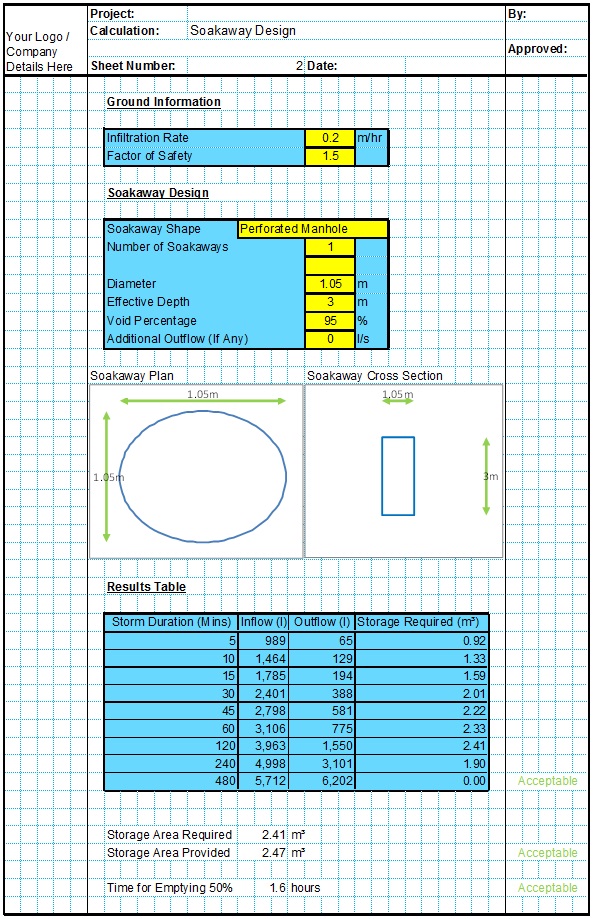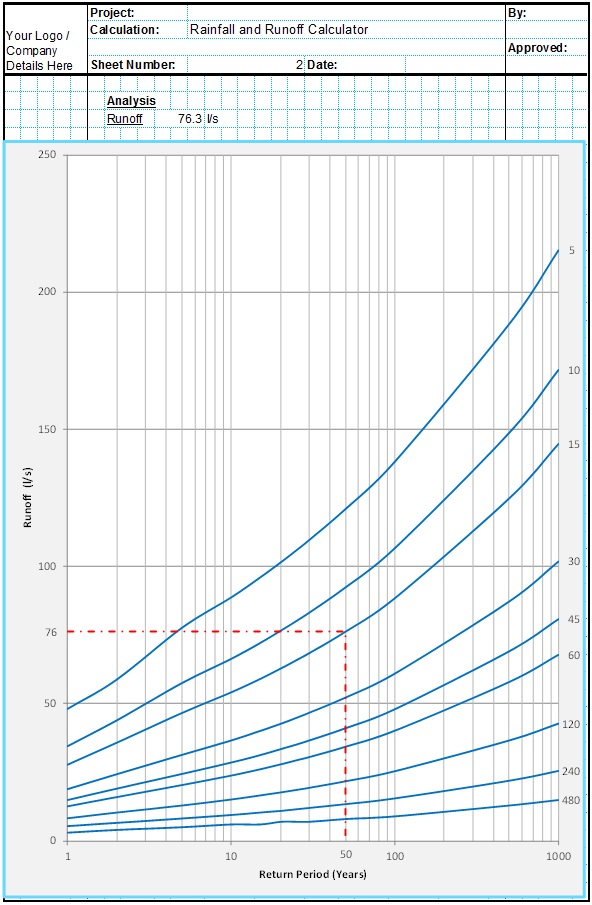The Time of Concentration is the time between rainfall landing on the catchment and the water reaching the point of the drainage system being considered. It is used to evaluate the critical storm duration for each point in the drainage system. This is because the critical rainfall event must be long enough for rainfall from the whole catchment to be contributing to the flow in the system at the point being considered. A storm of shorter duration may be more intense, but the water from a large portion of the catchment may not have reached the point being considered yet.
Time of Concentration and Storm Duration
In the rational method and similar runoff estimation methods such as the Wallingford Procedure Modified Rational Method, IH 124, ADAS 345 methods the time of concentration is used to determine the critical storm duration. This in turn is used to determine the design rainfall intensity for use in the rational method.
For unusual shaped catchments or where multiple sub-catchments are being considered, it is sometimes necessary for several storm durations to be considered to find the critical one. Another example may be where a small impervious area may have a larger runoff potential than the rest of the permeable catchment. In this case the time of concentration and runoff for the impermeable area only should be checked as well as the whole catchment.
Time of Concentration Calculations
There are two main methods of calculating the Time of Concentration for a catchment. The simplest is to apply an empirical formula. Several empirical formulas have been derived from experimental data which takes account of all the different types of flow from rainfall landing on the catchment to the outfall. These formulas are typically based on larger rural catchments. Examples include the Kirpich Equation, Bransby Williams Equation and the Kerby Formula.
The second more complex method is to break down the flow into its component parts and calculate each separately. The three main flow types are;
- Overland sheet flow. This is the flow that occurs immediately after the rain has landed as it heads towards a natural or man-made channel. This can be modeled using the kinematic wave formula or a variation such as the TR 55 Wave Equation.
- Concentrated shallow flow. This is the flow within a small, shallow natural or man-made channel, before the water reaches an inlet. This can be calculated using the equations of shallow overland flow such as the Manning Equation.
- Flow within a defined watercourse or drainage system. This is the flow from an inlet to the point of the system being considered. This can be calculated using the appropriate equations for open channel flow, pipe flow etc. As water is flowing through each part of the drainage system, each part has a slightly different time of concentration. This is often negligible but can be significant for very long or very shallow drainage runs.
Minimum Storm Duration
A minimum time of concentration of 5 minutes is usually applied to prevent small catchments from using extremely high rainfall intensities associated with a 1 or 2 minute storm event. In practice it is usually acceptable to expect a few minutes of flooding during extreme short duration storm intensities. In the UK a design storm duration of 5 minutes is often used for general drainage design purposes.
Time of Concentration Calculators
The CivilWeb Rainfall & Runoff Calculator package includes a free Time of Concentration calculator tool which can be used to evaluate the time of concentration for a catchment using a variety of different methods. These include the Kirpich Formula, TR55 method, Kinematic Wave Equation for sheet flow, Kerby Equation and the Bransby Williams Method.
Related Spreadsheets from CivilWeb;
Runoff Calculator Spreadsheet
This spreadsheet calculates the design runoff flow for a site in accordance with the a number of different methods including the Wallingford Procedure.
Attenuation Design Spreadsheet
This spreadsheet calculates the requirements for a attenuation system and assists the user to design a suitable system.
Soakaway Design Spreadsheet
This spreadsheet calculates the requirements for a soakaway system and assists the user to design a suitable system.
Full Drainage Design Suite
Full drainage design suite (50% Discount) including 7 spreadsheets;
- Colebrook White Pipe Design
- Manning Pipe Design
- Manning Open Channel Design
- Linear Drainage Design
- Runoff Calculator
- Attenuation Design
- Soakaway Design



